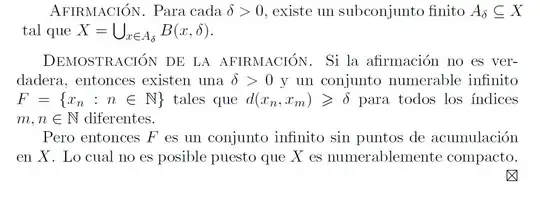The following statement is present in "Elementos de Topología General" by Angel Tamariz and Fidel Casarrubias.
Statement
Let be $X$ a metrizable countably compact space: so for any $\delta>0$ there exist a finite subset $A_\delta\subseteq X$ such that $X=\bigcup_{x\in A_\delta}B(x,\delta)$.
Proof. Previously we remember that any infinite countable subset of a contably compact space have a limit point. So if the statement was false then there exist $\delta>0$ and a countable subset $F=\{x_n:n\in\Bbb{N}\}$ such that $d(x_n,x_m)\ge \delta$ for any $m,n\in\Bbb{N}:n\neq m$, but this means that $F$ is an infinite contable subset such that has not limit points and this would be inconsisten with the hypothesis of the countable compactness of $X$.
So I don't understeand the following things:
- if the statement was false then there exist $\delta>0$ and a countable subset $F=\{x_n:n\in\Bbb{N}\}$ such that $d(x_n,x_m)\ge \delta$ for any $m,n\in\Bbb{N}:n\neq m$;
- If 1. was true then $F$ has not limit points.
As reference I say that "A space is countably compact if every countable cover has a finite subcover".
Then here the original proof in Spanish (I hope mine was a good translation).
Could someone help me, please?
